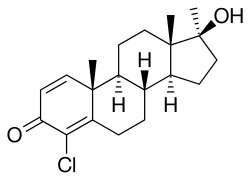Chlorodehydromethyltestosterone
 | |
| Clinical data | |
|---|---|
| Pregnancy category | |
| Routes of administration | Oral |
| Legal status | |
| Legal status |
|
| Pharmacokinetic data | |
| Bioavailability | 100% Oral |
| Metabolism | Hepatic |
| Biological half-life | 16 hours |
| Excretion | Kidneys (urine) |
| Identifiers | |
| |
| Synonyms | 4-Chlordehydromethyltestosterone; Dehydrochloromethyltestosterone; 4-Chloromethandienone |
| CAS Number | |
| PubChem CID | |
| ChemSpider | |
| UNII | |
| Chemical and physical data | |
| Formula | C20H27ClO2 |
| Molar mass | 334.89 g/mol |
| 3D model (JSmol) | |
| |
| |
| | |
Chlorodehydromethyltestosterone (CDMT) (brand name Oral Turinabol) is an anabolic-androgenic steroid (AAS). It is the 4-chloro-substituted derivative of metandienone (dehydromethyltestosterone) (Dianabol). CDMT was the first original product of Jenapharm, an East German pharmaceutical company. The patent registration took place in 1961. The idea of combining the structures of 4-chlorotestosterone (clostebol) and metandienone originated from the chemist Albert Stachowiak. At the time this represented a unique dissociation of anabolic and androgenic effects after oral administration.[1] The product had been introduced for clinical use in 1965.
Side effects
Misuse
CDMT was the key steroid administered to approximately 10,000 athletes from East Germany (GDR) as secret official policy, often without their knowing the nature of the "vitamins" they were forced to take. The doping program was run by the East German Government from about 1968 until 1989 when the Berlin wall was destroyed. The doping program was known as STASI 14.25. The doping was done in secret; it was only in the 1990s that Franke and Berendonk looked closely at the original archived information and discovered the true scope of just how well-planned and successful the doping regime had been (in terms of medal success and world record performances).[2]
After the collapse of the East German regime, people responsible for the forced doping were found guilty of causing grievous bodily harm to about 10,000 sportspeople; victims were compensated. In later life former athletes developed serious health problems believed due to the drugs; psychotic episodes were attributed to Oral Turinabol.[3]
Following allegations by the German documentary of widespread doping the IOC kicked off a reanalysis of Beijing 2008 and London 2012 samples (for all sports).
Weightlifters in particular were found to have used Dehydrochlormethyltestosterone – Most of the doped athletes coming from Russia, Ukraine and Belarus.[4] However, the method developed by Dr Grigory Rodchenkov in 2011[5] was used in 2016 to detect long-term metabolites of Oral Turinabol while retesting the athletes' Olympic samples.
See also
References
- ↑ Schwarz S, Onken D, Schubert A (July 1999). "The steroid story of Jenapharm: from the late 1940s to the early 1970s". Steroids. 64 (7): 439–45. PMID 10443899. doi:10.1016/S0039-128X(99)00003-3.
- ↑ Franke WW, Berendonk B (July 1997). "Hormonal doping and androgenization of athletes: a secret program of the German Democratic Republic government". Clin. Chem. 43 (7): 1262–79. PMID 9216474.
- ↑ Marie Katrin Kanitz, East German athlete (10 September 2016). "Experience: I didn't know I was being doped". The Guardian. Retrieved 10 September 2016.
- ↑ "Retests of Olympic Doping Samples *15 More Positives from 2008 Announced* - All Things Gym". All Things Gym. 2016-09-09. Retrieved 2016-12-31.
- ↑ Sobolevsky T, Rodchenkov G (2012). "Detection and mass spectrometric characterization of novel long-term dehydrochloromethyltestosterone metabolites in human urine". The Journal of Steroid Biochemistry and Molecular Biology. 128 (3-5): 121–7. PMID 22142641. doi:10.1016/j.jsbmb.2011.11.004.